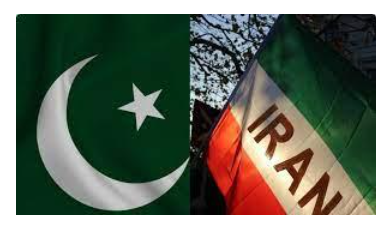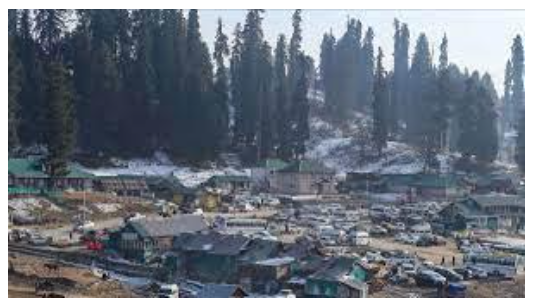Wednesday, 24th January 2024
Ayodhya Ram Temple: Contemporary Stone-Carved Architectural Marvel
In News: A modern marvel emerges in Ayodhya, symbolizing India's cultural and spiritual essence, this new landmark stands as a testament to devotion to Lord Ram.
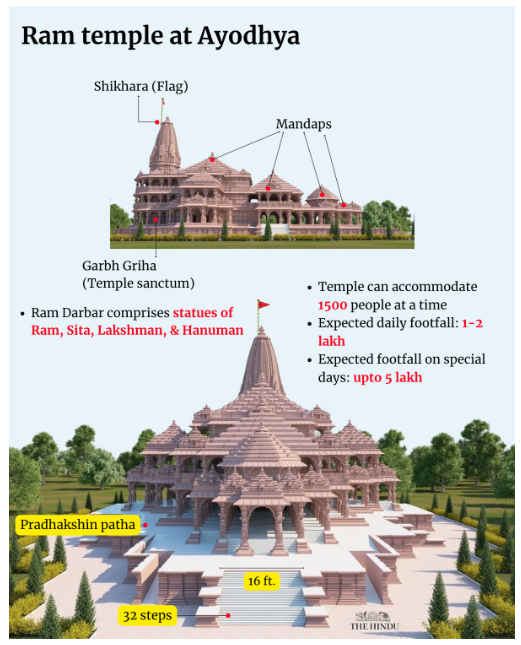
Major Features of the Ram Temple Main Complex
- Construction Materials
- The grand structure is constructed without the use of iron or steel.
- Stones used in the construction are sourced from Rajasthan's Bansi Paharpur area.
- Architectural Design
- Built in the traditional Nagara style.
- Dimensions: 380 feet long (east to west), 250 feet wide, and 161 feet high.
- Each floor is 20 feet high, featuring 392 pillars and 44 gates.
- Percota Periphery
- Surrounding the temple is a rectangular percota, a unique feature in north India.
- Percota is 14 feet wide, spanning 732 meters.
- Aesthetic Elements
- Stone carvings include images of Lord Hanuman, other deities, peacocks, and flower patterns.
- Divine aesthetics contribute to the overall appearance.
- Decorative Touch
- Over 3,000 kg of flowers from 20 varieties used for decoration.
Main Entrance
- Ornate statues at the main entrance:
- Elephants, lions, Lord Hanuman, and Garuda.
- Statues made from sandstone sourced from Bansi Paharpur.
Green Complex
- Green Area
- A significant portion (70%) of the complex designated as a green area.
- Hundreds of trees contribute to the green surroundings.
- Environmental Considerations
- Two sewage treatment plants within the complex.
- Water treatment plant and dedicated electricity line from the power house.
- Fire brigade post with access to water from an underground reservoir.
|
UPSC Previous Year Questions Prelims (2012) Q. The Nagara, the Dravida and the Vesara are the (a) three main racial groups of the Indian subcontinent Ans: c Mains (2013) Q. Chola architecture represents a high watermark in the evolution of temple architecture. Discuss Mains (2020) Q. Indian philosophy and tradition played a significant role in conceiving and shaping the monuments and their art in India. Discuss. |
Source: IE
India-Bangladesh Relations
In News: Bangladesh's Prime Minister Sheikh Hasina secured a historic fourth consecutive term, with India promptly extending congratulations, underscoring their strong bilateral ties.
How India-Bangladesh Relations Have Thrived
- Historical Ties
- Rooted in the 1971 Bangladesh Liberation War, with crucial Indian support.
- Periods of strain due to military regimes, resolved by Sheikh Hasina's leadership in 1996.
- Bilateral cooperation expanded into Trade, Energy, Infrastructure, Connectivity, and Defence.
- Economic Cooperation
- Steady growth in bilateral trade, reaching USD 18 billion in 2021-2022.
- India-Bangladesh joint feasibility study for a Comprehensive Economic Partnership Agreement (CEPA) in 2022.
- Infrastructure projects like the Akhaura-Agartala Rail Link enhance connectivity.
- Infrastructure Development
- India's Lines of Credit to Bangladesh surpass USD 7 billion since 2010.
- Resolution of long-pending issues like the Land Boundary Agreement (LBA) in 2015.
- Inauguration of the Akhaura-Agartala Rail Link in 2023 for improved connectivity.
- Energy Sector
- Bangladesh imports nearly 2,000 megawatts (MW) of electricity from India.
- Collaboration on the Rooppur Nuclear power plant project in 2018.
- Defence Cooperation
- Joint Exercises - Army (Exercise Sampriti) and Navy (Exercise Bongo Sagar).
- Shared border of 4096.7 km, the longest land boundary with any neighbor.
- Multilateral Cooperation
- Engagement in regional cooperation through SAARC, BIMSTEC, and IORA.
Points of Tensions
- Transboundary River Waters
- Only two treaties signed out of 54 common rivers, leading to ongoing negotiations.
- Illegal Migration
- Concerns over illegal migration impacting resources and security.
- Rohingya refugee crisis intensifying the issue.
- Drug Smuggling & Trafficking
- Cross-border incidences of drug smuggling, human trafficking, and poaching.
- Chinese Influence
- Bangladesh's active participation in the Belt and Road Initiative (BRI).
- Growing Chinese influence impacting India's regional standing.
Way Forward
- Cross-Border Challenges
- Establish joint task forces to combat drug smuggling and human trafficking.
- Shared intelligence and coordinated operations for disrupting illegal networks.
- Smart Border Management
- Utilize AI and data analytics for efficient cross-border movements.
- Ensure security while streamlining operations.
- Digital Connectivity
- Establish a digital connectivity corridor focusing on high-speed internet, digital services, and e-commerce.
- Create new avenues for trade, collaboration, and technological exchange.
|
UPSC Previous Year Questions Prelims (2017) Q. With reference to river Teesta, consider the following statements:
Which of the statements given above is/are correct? (a) 1 and 3 only Ans: (b) Mains (2018) Q. Analyze internal security threats and transborder crimes along Myanmar, Bangladesh and Pakistan borders including Line of Control (LoC). Also discuss the role played by various security forces in this regard. |
Source: TH
Social Audit Advisory Body
In News: The first meeting of the Social Audit Advisory Body (SAAB) occurred at the Dr. Ambedkar International Centre in New Delhi.
What is a Social Audit?
- Overview
- A systematic, independent evaluation of an organization's social impact and ethical performance.
- Focuses on aligning actions and policies with stated values, emphasizing community, employee, and environmental impact.
- Historical Context
- Coined by Howard Bowen in 1953 in the book "Social Responsibilities of the Businessman."
Key Features of Social Audit
- Fact-Finding Approach
- Emphasis on understanding rather than blaming.
- Stakeholder Dialogue
- Creates a platform for dialogue among diverse stakeholders.
- Grievance Redressal
- Timely resolution of grievances.
- Democracy and Institutions
- Strengthens democratic processes and institutions.
- People's Advocacy
- Mobilizes public pressure for improved program implementation.
Types of Social Audits
- Organizational
- Assessing a company's overall social responsibility efforts.
- Program-Specific
- Focusing on the impact and effectiveness of specific programs.
- Financial
- Reviewing social and environmental implications of financial decisions.
- Stakeholder-Driven
- Involving various stakeholders in the auditing process.
Framework Associated with Social Audit in India
- MGNREGA 2005
- Gram sabha responsible for monitoring work execution.
- Independent social audit units mandated for community-driven verification.
- Meghalaya Community Participation Act 2017
- First state-level legislation mandating social audits.
- BOCW Act Framework
- Ministry of Labour & Employment's framework for social audits.
- Right to Information Act 2005
- Enhances transparency and access to information.
- NRCSA
- National Resource Cell for Social Audit ensures social audits at state levels.
Challenges Related to Social Audit in India
- Lack of Standardization
- Absence of standardized procedures leading to variations.
- Awareness and Capacity
- Limited understanding hampers effective implementation.
- Limited Participation
- Inadequate involvement of marginalized groups affects assessments.
- Political Interference
- Influence from authorities compromises independence.
- Resource Constraints
- Financial and human resource limitations impact effectiveness.
- Capacity and Training
- Social audit units lack funds and trained professionals.
Way Forward
- Blockchain for Transparency
- Explore blockchain technology for secure and tamper-proof audit information.
- Accessibility and Representation
- Simplify processes and provide information in local languages.
- Diverse Participation
- Encourage participation from marginalized groups through incentives.
- Standardization and Protection
- Develop uniform guidelines for social audits and enact whistleblower protection.
|
UPSC Previous Year Questions Mains (2021) Q. An independent and empowered social audit mechanism is an absolute must in every sphere of public service, including judiciary, to ensure performance, accountability and ethical conduct. Elaborate. |
Source: PIB
RoDTEP Scheme
In News: The Centre has no plans to revise the RoDTEP scheme for exporters, despite the imposition of anti-subsidy duties by the US government.
Understanding the Remission of Duties and Taxes on Exported Products (RoDTEP) Scheme
- Introduction
- Launched by the Ministry of Commerce & Industry, effective from January 1, 2021.
- Replaces the existing MEIS (Merchandise Exports from India Scheme).
- Objectives
- Aims to ensure exporters receive refunds on previously non-recoverable embedded taxes and duties.
- Intended to boost export volumes.
- Need for the RoDTEP Scheme
- Originated in response to WTO ruling against India's export subsidy schemes.
- WTO dispute panel recommended withdrawal of existing subsidy programs.
- RoDTEP designed to make India WTO-compliant.
- Features of the RoDTEP Scheme
- Refund of previously non-refundable duties and taxes, including Mandi tax, VAT, Coal cess, and Central Excise duty on fuel.
- Automated credit system issued as a transferable electronic scrip by CBIC.
- Quick verification facilitated through digitization.
- Multi-sector coverage with a priority for labor-intensive sectors previously benefiting from the MEIS Scheme.
- Eligibility Criteria
- Both manufacturer exporters and merchant exporters (traders) eligible.
- Exported products must have India as the country of origin.
- No turnover threshold for RoDTEP claims.
- Special Economic Zone Units and Export Oriented Units also eligible.
- Applies to goods exported via courier through e-commerce platforms, excluding re-exported products.
- Issues in RoDTEP Scheme Implementation
- Global principle: Taxes and duties should not be exported.
- Countervailing duties imposed by the US and EU against RoDTEP payments availed.
- Challenges in obtaining detailed records of input taxes, particularly for hand-written invoices.
- Streamlining and proper training needed for exporters to comply effectively.
Source: BL
Pradhan Mantri Suryodaya Yojana
In News: Prime Minister Modi unveiled the 'Pradhan Mantri Suryodaya Yojana,' a government initiative to provide rooftop solar power systems to one crore households.
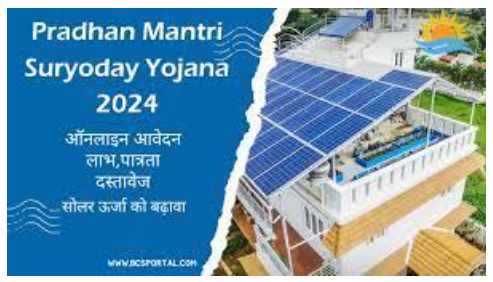
Previous Initiatives for Rooftop Solar Promotion
- Introduction
- In 2014, the government launched the Rooftop Solar Programme.
- Aiming for 40 GW cumulative installed capacity by 2022.
- Target Achievement and Extension
- By the end of 2023, only 11 GW rooftop solar energy generated.
- The deadline extended to 2026 due to unmet targets.
- Features of the Rooftop Solar Programme
- Consumer benefits through DISCOM tendered projects or the National Portal.
- DISCOMs' role limited to technical feasibility, net-meter installation, and system inspection.
- Net metering allows credits for surplus solar energy added to the grid.
- Monetary benefits for surplus power as per prevailing regulations.
Pradhan Mantri Suryodaya Yojana
- Overview
- New scheme aiming to achieve 40 GW rooftop solar capacity.
- Implementation Details
- Involves installing solar power systems on residential rooftops.
- Aims to reduce electricity bills for the poor and middle class.
- Current Solar Capacity in India
- Installed Capacity
- Total solar power capacity: 73.31 GW (as of December 2023).
- Rooftop solar capacity: 11.08 GW (as of December 2023).
- State-wise Performance
- Rajasthan leads in total solar capacity (18.7 GW).
- Gujarat tops in rooftop solar capacity (2.8 GW).
- Installed Capacity
Need for Solar Energy Expansion in India
- World Energy Outlook by IEA
- India expected to witness the largest energy demand growth globally over the next 30 years.
- IEA emphasizes the need for sustainable and secure energy sources.
- Renewable Energy Goals
- India targets 500 GW of renewable energy capacity by 2030.
- A shift towards reliable and sustainable energy sources.
Source: IE
Distress Alert Transmitter for Fishermen
In News: ISRO has introduced the second-generation Distress Alert Transmitter (DAT-SG), a homegrown technology enabling fishermen at sea to send emergency messages from their boats.
Distress Alert Transmitter (DAT) and Second Generation DAT-SG
About the First Version of DAT
- Operational since 2010.
- Messages sent through communication satellites to INMCC (Indian Mission Control Centre).
- Alert signals decoded for identity and location of fishing boats.
- Information forwarded to MRCCs under the Indian Coast Guard for search and rescue operations.
- Over 20,000 DATs in use.
Introduction to DAT-SG
- Enhanced Capabilities
- Builds upon the original DAT for improved maritime safety and communication.
- Acknowledgement Feature
- Can send acknowledgements to fishermen activating distress alerts from sea.
- NavIC Receiver Module
- UHF transmitter based on NavIC receiver module developed by ISRO.
- Supports position determination and broadcast messages reception (NavIC messaging service).
- Advanced Features
- Bluetooth Interface: Connects to mobile phones, enabling message reception and app-based reading in native languages.
- Integration with Mobile Phones: Provides a widely-used platform for communication.
- SAGARMITRA Network Management System
- Web-based system at INMCC.
- Manages registered DAT-SGs.
- Assists MRCCs in accessing real-time information for prompt Search & Rescue operations.
- Two-Way Communication
- Capable of receiving messages from the control center.
- Enables the central control station to send advance alerts to fishermen about events like bad weather or emergencies.
- Information Transmission
- Can transmit details about Potential Fishing Zones (PFZs) to aid fishermen in locating productive areas.
- Operational 24/7
- DAT-SG services are available 24x7, ensuring continuous support for fishermen in distress.
|
UPSC Previous Year Questions Prelims (2018) Q. With reference to the Indian Regional Navigation Satellite System (IRNSS), consider the following statements:
Which of the statements given above is/are correct? (a) 1 only Ans: (a) Mains (2018) Q. Why is Indian Regional Navigational Satellite System (IRNSS) needed? How does it help in navigation? Mains (2016) Q. Discuss India’s achievements in the field of Space Science and Technology. How the application of this technology has helped India in its socio-economic development? |
Source: ET
FiloBot
In News: A novel robot called FiloBot, inspired by plants, has been created to climb structures in a manner reminiscent of climbing vines.
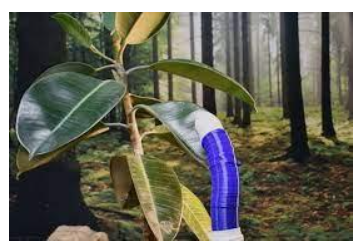
About FiloBot
- Distinct from Conventional Climbing Robots
- Unlike traditional climbing robots, FiloBot doesn't rely on pre-programmed movements.
- It absorbs 3D printing filament and extends its length over time, resembling a creeper.
- Bioinspired Behaviors
- Utilizes plant behaviors like phototropism, negative phototropism, and gravitropism.
- Incorporates these natural behaviors into high-tech robots.
- Successful Tests
- Demonstrated remarkable adaptability.
- Adjusts its growth trajectory dynamically in response to changing light intensity.
Significance
- Equipping autonomous systems with transportable additive manufacturing techniques and bioinspired behaviors.
- Enables robots to navigate unstructured and dynamic environments.
- Capable of self-building infrastructure, expanding the potential impact of technology in robotics.
Other Similar Innovations
- NASA's Jet Propulsion Laboratory unveiled EELS 1.0, a snake-like robot.
- Crafted for exploration on rough terrains of planets and moons.
- Engineered to navigate diverse landscapes, including ice, sand, cliff walls, deep craters, and lava tubes.
Source: WION
Exercise KHANJAR
In News: The India-Kyrgyzstan Joint Special Forces Exercise KHANJAR has started at the Special Forces Training School in Bakloh, Himachal Pradesh.
About Exercise Khanjar
- Initiation
- Commenced in December 2011 in Nahan, India.
- Edition and Frequency
- 11th edition of the India-Kyrgyzstan Joint Special Forces Exercise.
- An annual event alternately conducted in both countries.
- Participants
- Indian Army contingent (20 personnel) represented by The Parachute Regiment (Special Forces).
- Kyrgyzstan contingent (20 personnel) represented by Scorpion Brigade.
- Objective
- Exchange experiences and best practices in Counter Terrorism and Special Forces Operations.
- Focus on Built-up Area and Mountainous Terrain under Chapter VII of the United Nations Charter.
- Training Emphasis
- Develop Special Forces skills.
- Learn advanced techniques of insertion and extraction.
- Purpose
- Strengthen defence ties.
- Address common concerns of international terrorism and extremism.
- Showcasing Capabilities
- Provide an opportunity to display cutting-edge indigenous defence equipment.
- Achieve shared security objectives and foster bilateral relations.
Source: PIB
Madhika
In News: The Chakaliya community in the secluded colony of Kookanam, near Karivellur Grama Panchayat in Kerala, is facing the imminent disappearance of its distinct language, Madhika.
About Madhika Language
- Chakaliya Community Language
- Spoken by the Chakaliya community.
- Lacks a written script.
- Distinct Influences
- Despite similarities to Kannada, it can be perplexing due to diverse linguistic influences.
- Blend of Languages
- Fusion of Telugu, Tulu, Kannada, and Malayalam.
- Major influence from Havyaka Kannada, an archaic form of Kannada.
- Endangered Status
- Facing extinction, especially with the younger generation favoring Malayalam.
Key Facts about Chakaliya Community
- Nomadic Origins
- Originally a nomadic community.
- Devotees of Thiruvenkatramana and Mariamma.
- Migration History
- Migrated from hilly regions of Karnataka to northern Malabar centuries ago.
- Recognition and Categorization
- Initially recognized as a Scheduled Tribe.
- Later included in the Scheduled Caste category in Kerala.
- Historical Mention
- Referenced in the book "Caste and Tribes of Southern India."
Government of India's Language Preservation Initiative
- Scheme for Protection and Preservation of Endangered Languages of India (SPPEL)
- Initiated by the Government of India.
- Central Institute of Indian Languages (CIIL), Mysore, focuses on safeguarding languages spoken by fewer than 10,000 people.
- CIIL's Role
- Works on protection, preservation, and documentation of endangered languages.
- Aims to ensure the survival of all mother tongues/languages in India.
Source: TH
Binturong (Arctictis binturong) and the Small-Clawed Otter
In News: Kaziranga National Park and Tiger Reserve in Assam recently welcomed two new mammalian species: the elusive binturong (Arctictis binturong) and the small-clawed otter.

About Binturong
- Largest Civet in India
- Colloquially known as the bearcat.
- Common names: Asian Bearcat and the Asian Civet.
- Scientific name: Arctictis binturong.
- Behavior and Characteristics
- Generally solitary and nocturnal.
- Moves slowly and cautiously in trees.
- Possesses scent glands under its tail for marking territory.
- Family and Tail Adaptation
- Belongs to the same family as Civets, Genets, Mongooses, and Fossa.
- One of only two carnivores with a prehensile tail (the other being the kinkajou).
- Prehensile tail aids in climbing and provides stability.
- Habitat and Distribution
- Medium-sized carnivore in the dense forests of South-East Asia.
- Found in China, India, Thailand, Cambodia, Laos, Malaysia, Indonesia, the Philippines, and Borneo.
- Conservation Status
- IUCN: Vulnerable.
- Wildlife Protection Act of 1972: Schedule I.
- CITES: Appendix III.
Key Facts about Small-clawed Otter
- Adaptations for Aquatic Hunting
- Exhibits partially webbed feet and short claws for adept hunting in aquatic environments.
- Distribution Range
- Spans from India eastwards to Southeast Asia and southern China.
- In India, primarily found in protected areas in West Bengal, Assam, Arunachal Pradesh, Karnataka, Tamil Nadu, and certain regions of Kerala within the Western Ghats.
- Habitat and Diet
- Primarily inhabits freshwater habitats.
- Diet includes fish and crustaceans.
- Threats
- Faces threats from habitat destruction, deforestation, and reduction in prey biomass.
- Conservation Status
- IUCN: Vulnerable.
- Wildlife Protection Act of 1972: Schedule I.
- CITES: Appendix I.
Source: FE
Competition Commission of India
In News: Amrit Kaal, the next 25 years, brings technological advancements and economic shifts. The CCI is vital for fostering a competitive, inclusive, and resilient economic environment.
Historical Context of Indian Economy
- India's Post-Independence Economic Evolution
- Initial adoption of a closed economy model with import substitution and heavy government intervention.
- Focus on self-sufficiency in various sectors.
- Paradigm shift in the early 1990s with economic liberalisation reforms.
- Integration into the Global Market Post Economic Liberalisation
- Embrace of market-oriented policies, liberalising trade, deregulating industries, and encouraging foreign direct investment (FDI).
- Increased trade and investment flows, transitioning from an agrarian to a diverse and dynamic economy.
- India’s Current Economic Landscape
- New Digital Revolution
- Amrit Kaal ushering in a digital revolution.
- Technology as a driving force behind business operations, innovation, and communication.
- New Digital Revolution
- Emerging New Business Models
- Emergence of novel business models, especially in the digital and tech sectors.
- Start-ups and tech-driven enterprises reshaping traditional industries.
The Significance of Competition Commission of India in India’s Economic Journey
- Enforcement Actions
- Addressing Anti-Competitive Practices
- CCI empowered to eliminate practices adversely affecting competition.
- Investigation and action against anti-competitive agreements including cartelisation and price-fixing.
- Scrutinising Dominant Companies
- Examination of conduct of dominant companies to prevent market abuse.
- Investigation into practices like predatory pricing and denial of market access.
- Remedial Solutions
- Authority to issue punitive and remedial solutions in case of anti-competitive behavior.
- Measures designed to rectify market distortions and restore fair competition.
- Addressing Anti-Competitive Practices
- Advocacy Measures
- Fostering a Culture of Competition
- CCI engages in advocacy to promote a competitive culture.
- Collaboration with stakeholders, industry participants, and the public to encourage compliance with competition laws.
- Educating Stakeholders
- Pivotal role in educating stakeholders about the benefits of fair competition.
- Enhancing awareness and understanding to create a market where businesses operate on a level playing field.
- Policy Recommendations
- CCI provides opinions and recommendations on policy matters affecting competition.
- Ensuring the regulatory framework remains adaptive to evolving market dynamics.
- Broad Mandates of CCI
- Elimination of adverse practices harming competition.
- Active promotion and sustenance of fair competition.
- Commitment to consumer protection, ensuring fair prices, quality products, and diverse options.
- Fostering a Culture of Competition
New-Age Challenges to Competition Commission of India (CCI)
- Market Concentration
- Digital economy characterized by the dominance of a few tech giants.
- Potential for monopolistic positions, limiting competition.
- Stifling of Innovation
- Concentration of power hindering innovation by smaller competitors.
- Predatory Pricing
- Engagement in predatory pricing strategies by tech giants.
- Risk of eliminating competition and establishing a monopolistic market.
- Exclusive Agreements
- Use of exclusive agreements restricting access to products or services.
- Creating barriers for new entrants and limiting consumer choices.
CCI’s Approach in Handling New-Age Challenges
- Need for a Better Understanding of the Global Nature of Digital Markets
- Collaboration with international counterparts for effective global cooperation.
- Development of strategies to address challenges posed by the transnational nature of digital markets.
- Need to Adapt Dynamic Technological Changes
- Continuous updating of regulatory frameworks to address emerging challenges.
- Adaptation to the dynamic nature of digital markets.
- Employ Multifaceted Approach to Regulation
- Striking a balance between fostering innovation and implementing necessary regulations.
- Nuanced regulatory interventions to avoid stifling innovation while preventing market distortions.
Conclusion
- As India's economy looks to the future, CCI's commitment to building resilience and agility becomes paramount.
- Proactive identification of potential market disruptions, research investments, expertise building, and technological leverage are key.
- CCI reiterates its commitment to steering India's economic journey towards competitiveness, inclusivity, and resilience on marking 75 years of independence.
Source: FE
Share the article
Edukemy’s Current Affairs Quiz is published with multiple choice questions for UPSC exams
MCQ
Get Latest Updates on Offers, Event dates, and free Mentorship sessions.

Get in touch with our Expert Academic Counsellors 👋
FAQs
UPSC Daily Current Affairs focuses on learning current events on a daily basis. An aspirant needs to study regular and updated information about current events, news, and relevant topics that are important for UPSC aspirants. It covers national and international affairs, government policies, socio-economic issues, science and technology advancements, and more.
UPSC Daily Current Affairs provides aspirants with a concise and comprehensive overview of the latest happenings and developments across various fields. It helps aspirants stay updated with current affairs and provides them with valuable insights and analysis, which are essential for answering questions in the UPSC examinations. It enhances their knowledge, analytical skills, and ability to connect current affairs with the UPSC syllabus.
UPSC Daily Current Affairs covers a wide range of topics, including politics, economics, science and technology, environment, social issues, governance, international relations, and more. It offers news summaries, in-depth analyses, editorials, opinion pieces, and relevant study materials. It also provides practice questions and quizzes to help aspirants test their understanding of current affairs.
Edukemy's UPSC Daily Current Affairs can be accessed through:
- UPSC Daily Current Affairs can be accessed through Current Affairs tab at the top of the Main Page of Edukemy.
- Edukemy Mobile app: The Daily Current Affairs can also be access through Edukemy Mobile App.
- Social media: Follow Edukemy’s official social media accounts or pages that provide UPSC Daily Current Affairs updates, including Facebook, Twitter, or Telegram channels.

